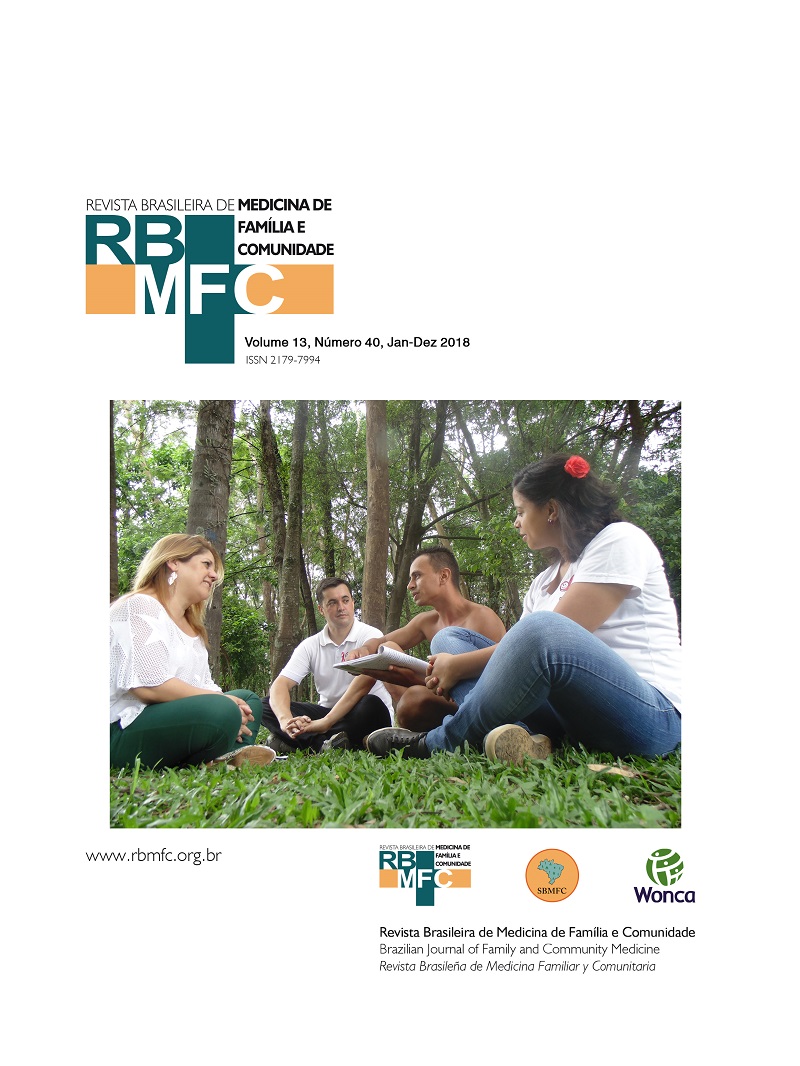When HbA1c is not enough: a case of Baltimore Hemoglobin
DOI:
https://doi.org/10.5712/rbmfc13(40)1746Keywords:
Diabetes Mellitus, Glycated Hemoglobin A, Hemoglobins, AbnormalAbstract
The haemoglobin A1c (HbA1c) test is the gold standard in monitoring diabetes mellitus. HbA1c can be falsely decreased or increased in some particular scenarios, as in hemoglobinopathies, inadequately reporting the glycemic control. Here we present the case of a patient with a HbA1c value incompatible with self-monitoring blood glucose levels, due to the presence of hemoglobin N-Baltimore. This case is relevant because, in spite of being asymptomatic, the presence of this type of hemoglobin leads to an incorrect appearance of glycemic control, if standard methods for HbA1c determination are used.
Downloads
Metrics
References
Atualização sobre hemoglobina glicada (A1C) para avaliação do controle glicêmico e para o diagnóstico do diabetes: aspectos clínicos e laboratoriais. Posicionamento Oficial SBD, SBPC-ML, SBEM e FENAD 2017/2018 [Internet]. [acesso 2018 Set 8]. Disponível em: https://www.diabetes.org.br/publico/images/banners/posicionamento-3-2.pdf
Gargallo MA, González FA, Villegas A. Abnormally low HbA1c secondary to hemoglobin J-Baltimore [beta 16(A13) Gly-->Asp]. Family study. Endocrinol Nutr. 2010;57(2):83-5. http://dx.doi.org/10.1016/j.endonu.2010.01.004 DOI: https://doi.org/10.1016/j.endonu.2010.01.004
Beck RW, Connor CG, Mullen DM, Wesley DM, Bergenstal RM. The Fallacy of Average: How Using HbA1c Alone to Assess Glycemic Control Can Be Misleading. Diabetes Care. 2017;40(8):994-9. http://dx.doi.org/10.2337/dc17-0636 DOI: https://doi.org/10.2337/dc17-0636
Wheeler E, Leong A, Liu CT, Hivert MF, Strawbridge RJ, Podmore C, et al. Impact of common genetic determinants of Hemoglobin A1c on type 2 diabetes risk and diagnosis in ancestrally diverse populations: A transethnic genome-wide meta-analysis. PLoS Med. 2017;14(9):e1002383. http://dx.doi.org/10.1371/journal.pmed.1002383 DOI: https://doi.org/10.1371/journal.pmed.1002383
HbVar: A database of human hemoglobin variants and thalassemias [Internet]. [acesso 2018 Set 8]. Disponível em: http://globin.bx.psu.edu/cgi-bin/hbvar/counter
Bonini-Domingos CR, Silveira ELV, Viana-Baracioli LMS, Canali AA. Caracterização de hemoglobina N-Baltimore em doador de sangue de São José do Rio Preto, SP. J Bras Patol Med Lab. 2003;39(1):41-4. http://dx.doi.org/10.1590/S1676-24442003000100008 DOI: https://doi.org/10.1590/S1676-24442003000100008
American Diabetes Association. 6. Glycemic Targets: Standards of Medical Care in Diabetes-2018. Diabetes Care. 2018;41(Suppl 1):S55-64. http://dx.doi.org/10.2337/dc18-S006 DOI: https://doi.org/10.2337/dc18-S006
Bennett WL, Maruthur NM, Singh S, Segal JB, Wilson LM, Chatterjee R, et al Comparative effectiveness and safety of medications for type 2 diabetes: an update including new drugs and 2-drug combinations. Ann Intern Med. 2011;154(9):602-13. http://dx.doi.org/10.7326/0003-4819-154-9-201105030-00336 DOI: https://doi.org/10.7326/0003-4819-154-9-201105030-00336
Diabetes Control and Complications Trial Research Group, Nathan DM, Genuth S, Lachin J, Cleary P, Crofford O, Davis M, et al. The effect of intensive treatment of diabetes on the development and progression of long-term complications in insulin-dependent diabetes mellitus. N Engl J Med. 1993;329(14):977-86. http://dx.doi.org/10.1056/NEJM199309303291401 DOI: https://doi.org/10.1056/NEJM199309303291401
Intensive blood-glucose control with sulphonylureas or insulin compared with conventional treatment and risk of complications in patients with type 2 diabetes (UKPDS 33). UK Prospective Diabetes Study (UKPDS) Group. Lancet. 1998;352(9131):837-53. http://dx.doi.org/10.1016/S0140-6736(98)07019-6 DOI: https://doi.org/10.1016/S0140-6736(98)07019-6
Rahbar S. The discovery of glycated hemoglobin: a major event in the study of nonenzymatic chemistry in biological systems. Ann N Y Acad Sci. 2005;1043:9-19. http://dx.doi.org/10.1196/annals.1333.002 DOI: https://doi.org/10.1196/annals.1333.002
Sacks DB. Hemoglobin variants and hemoglobin A1c analysis: problem solved? Clin Chem. 2003;49(8):1245-7. http://dx.doi.org/10.1373/49.8.1245 DOI: https://doi.org/10.1373/49.8.1245
Bry L, Chen PC, Sacks DB. Effects of hemoglobin variants and chemically modified derivatives on assays for glycohemoglobin. Clin Chem. 2001;47(2):153-63. DOI: https://doi.org/10.1093/clinchem/47.2.153
Lorenzo-Medina M, Nogueira-Salgueiro P, Martin-Aguila A, Ruiz-Garcia L. Interference of Hemoglobin N-Baltimore on Measurement of HbA1c Using the HA-8160 and HA-8180 HPLC Methods. J Diabetes Sci Technol. 2015;9(3):714-5. http://dx.doi.org/10.1177/1932296815574723 DOI: https://doi.org/10.1177/1932296815574723
National Glycohemoglobin Standardization Program (NGSP). Factors that interfere with HbA1c test results [Internet]. [acesso 2018 Set 7]. Disponível em: www.ngsp.org/factors.asp
Downloads
Published
How to Cite
Issue
Section
License
By submitting a manuscript to the RBMFC, authors retain ownership of the copyright in the article, and authorize RBMFC to publish that manuscript under the Creative Commons Attribution 4.0 license and identify itself as the vehicle of its original publication.















